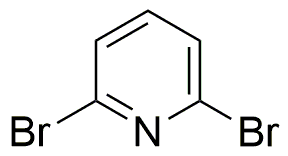2,6-Dibromopyridine is widely utilized in research focused on:
- Synthesis of Pharmaceuticals: This compound serves as an important intermediate in the synthesis of various pharmaceutical agents, particularly those targeting neurological disorders.
- Agricultural Chemicals: It is used in the development of agrochemicals, including pesticides and herbicides, enhancing crop protection and yield.
- Material Science: The compound is involved in creating advanced materials, such as polymers and coatings, which offer improved durability and resistance to environmental factors.
- Organic Electronics: 2,6-Dibromopyridine plays a crucial role in the fabrication of organic semiconductors, contributing to the development of efficient electronic devices.
- Research and Development: It is frequently used in academic and industrial research to explore new chemical reactions and pathways, facilitating innovation in various fields.
General Information
Properties
Safety and Regulations
Applications
2,6-Dibromopyridine is widely utilized in research focused on:
- Synthesis of Pharmaceuticals: This compound serves as an important intermediate in the synthesis of various pharmaceutical agents, particularly those targeting neurological disorders.
- Agricultural Chemicals: It is used in the development of agrochemicals, including pesticides and herbicides, enhancing crop protection and yield.
- Material Science: The compound is involved in creating advanced materials, such as polymers and coatings, which offer improved durability and resistance to environmental factors.
- Organic Electronics: 2,6-Dibromopyridine plays a crucial role in the fabrication of organic semiconductors, contributing to the development of efficient electronic devices.
- Research and Development: It is frequently used in academic and industrial research to explore new chemical reactions and pathways, facilitating innovation in various fields.
Documents
Safety Data Sheets (SDS)
The SDS provides comprehensive safety information on handling, storage, and disposal of the product.
Product Specification (PS)
The PS provides a comprehensive breakdown of the product’s properties, including chemical composition, physical state, purity, and storage requirements. It also details acceptable quality ranges and the product's intended applications.
Certificates of Analysis (COA)
Search for Certificates of Analysis (COA) by entering the products Lot Number. Lot and Batch Numbers can be found on a product’s label following the words ‘Lot’ or ‘Batch’.
*Catalog Number
*Lot Number
Certificates Of Origin (COO)
This COO confirms the country where the product was manufactured, and also details the materials and components used in it and whether it is derived from natural, synthetic, or other specific sources. This certificate may be required for customs, trade, and regulatory compliance.
*Catalog Number
*Lot Number
Safety Data Sheets (SDS)
The SDS provides comprehensive safety information on handling, storage, and disposal of the product.
DownloadProduct Specification (PS)
The PS provides a comprehensive breakdown of the product’s properties, including chemical composition, physical state, purity, and storage requirements. It also details acceptable quality ranges and the product's intended applications.
DownloadCertificates of Analysis (COA)
Search for Certificates of Analysis (COA) by entering the products Lot Number. Lot and Batch Numbers can be found on a product’s label following the words ‘Lot’ or ‘Batch’.
*Catalog Number
*Lot Number
Certificates Of Origin (COO)
This COO confirms the country where the product was manufactured, and also details the materials and components used in it and whether it is derived from natural, synthetic, or other specific sources. This certificate may be required for customs, trade, and regulatory compliance.


